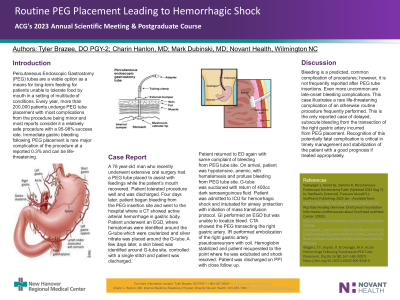Monday Poster Session
Category: General Endoscopy
P2013 - Routine PEG Placement Leading to Hemorrhagic Shock
Monday, October 23, 2023
10:30 AM - 4:15 PM PT
Location: Exhibit Hall

Has Audio

Tyler Brazee, DO
Novant Hospital New Hanover Regional Medical Center
Wilmington, NC
Presenting Author(s)
Tyler Brazee, DO1, Charin Hanlon, MD2, Mark Dubinski, MD2
1Novant Hospital New Hanover Regional Medical Center, Wilmington, NC; 2Novant Hospital, Wilmington, NC
Introduction: Percutaneous Endoscopic Gastrostomy (PEG) tubes are a viable option as a means for long-term feeding for patients unable to tolerate food by mouth in a setting of multitude of conditions. Every year, more than 200,000 patients undergo PEG tube placement with most complications from the procedure being minor and most reports consider it a relatively safe procedure with a 95-98% success rate. Immediate gastric bleeding following PEG placement is rare major complication of the procedure at a reported 0.3% and can be life-threatening.
Case Description/Methods: A 78 year-old man who recently underwent extensive oral surgery had a PEG tube placed to assist with feedings while the patient’s mouth recovered. Patient tolerated procedure well and was discharged. Four days later, patient began bleeding from the PEG insertion site and went to the hospital where a CT showed active arterial hemorrhage in gastric body. Patient underwent an EGD, where hematomas were identified around the G-tube which were cauterized and silver nitrate was placed around the G-tube. A few days later, a skin bleed was identified around G-tube site, controlled with a single stitch and patient was discharged. Patient returned to ED again with same complaint of bleeding from PEG tube site. On arrival, patient was hypotensive, anemic, with hematemesis and profuse bleeding from PEG tube site. G-tube was suctioned with return of 400cc dark serosanguinous fluid. Patient was admitted to ICU for hemorrhagic shock and intubated for airway protection with initiation of mass transfusion protocol. GI performed an EGD but was unable to localize bleed. CTA showed the PEG transecting the right gastric artery. IR performed embolization of the right gastric artery pseudoaneurysm with coil. Hemoglobin stabilized and patient recuperated to the point where he was extubated and shock resolved. Patient was discharged on PPI with close follow up.
Discussion: Bleeding is a predicted, common complication of procedures; however, it is not frequently reported after PEG tube insertions. Even more uncommon are late-onset bleeding complications. This case illustrates a rare life-threatening complication of an otherwise routine procedure frequently performed. This is the only reported case of delayed, subacute bleeding from the transection of the right gastric artery incurred from PEG placement. Recognition of this potentially fatal complication is critical in timely management and stabilization of the patient with a good prognosis if treated appropriately.
Disclosures:
Tyler Brazee, DO1, Charin Hanlon, MD2, Mark Dubinski, MD2. P2013 - Routine PEG Placement Leading to Hemorrhagic Shock, ACG 2023 Annual Scientific Meeting Abstracts. Vancouver, BC, Canada: American College of Gastroenterology.
1Novant Hospital New Hanover Regional Medical Center, Wilmington, NC; 2Novant Hospital, Wilmington, NC
Introduction: Percutaneous Endoscopic Gastrostomy (PEG) tubes are a viable option as a means for long-term feeding for patients unable to tolerate food by mouth in a setting of multitude of conditions. Every year, more than 200,000 patients undergo PEG tube placement with most complications from the procedure being minor and most reports consider it a relatively safe procedure with a 95-98% success rate. Immediate gastric bleeding following PEG placement is rare major complication of the procedure at a reported 0.3% and can be life-threatening.
Case Description/Methods: A 78 year-old man who recently underwent extensive oral surgery had a PEG tube placed to assist with feedings while the patient’s mouth recovered. Patient tolerated procedure well and was discharged. Four days later, patient began bleeding from the PEG insertion site and went to the hospital where a CT showed active arterial hemorrhage in gastric body. Patient underwent an EGD, where hematomas were identified around the G-tube which were cauterized and silver nitrate was placed around the G-tube. A few days later, a skin bleed was identified around G-tube site, controlled with a single stitch and patient was discharged. Patient returned to ED again with same complaint of bleeding from PEG tube site. On arrival, patient was hypotensive, anemic, with hematemesis and profuse bleeding from PEG tube site. G-tube was suctioned with return of 400cc dark serosanguinous fluid. Patient was admitted to ICU for hemorrhagic shock and intubated for airway protection with initiation of mass transfusion protocol. GI performed an EGD but was unable to localize bleed. CTA showed the PEG transecting the right gastric artery. IR performed embolization of the right gastric artery pseudoaneurysm with coil. Hemoglobin stabilized and patient recuperated to the point where he was extubated and shock resolved. Patient was discharged on PPI with close follow up.
Discussion: Bleeding is a predicted, common complication of procedures; however, it is not frequently reported after PEG tube insertions. Even more uncommon are late-onset bleeding complications. This case illustrates a rare life-threatening complication of an otherwise routine procedure frequently performed. This is the only reported case of delayed, subacute bleeding from the transection of the right gastric artery incurred from PEG placement. Recognition of this potentially fatal complication is critical in timely management and stabilization of the patient with a good prognosis if treated appropriately.
Disclosures:
Tyler Brazee indicated no relevant financial relationships.
Charin Hanlon indicated no relevant financial relationships.
Mark Dubinski indicated no relevant financial relationships.
Tyler Brazee, DO1, Charin Hanlon, MD2, Mark Dubinski, MD2. P2013 - Routine PEG Placement Leading to Hemorrhagic Shock, ACG 2023 Annual Scientific Meeting Abstracts. Vancouver, BC, Canada: American College of Gastroenterology.
